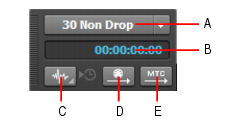















. Transmit MIDI Sync to external MIDI devices, such as drum machines, stand-alone MIDI hardware sequencers, and sequencers built into MIDI keyboards (only available when using the Internal or Audio clock). SONAR sends messages to all other devices to start and stop playback and to keep all the devices in sync. SONAR can send MIDI Sync on multiple MIDI output ports. For details, see MIDI synchronization.

. Transmit MIDI Time Code (MTC) to external devices that can receive MTC. SMPTE/MTC is a position and timing reference that indicates the current location in the project and how quickly the project should be playing. SMPTE/MTC time code labels the position in a project in hours, minutes, seconds, and frames. The speed of playback is indicated by a frame rate. SONAR can send MTC on multiple output ports simultaneously. For details, see SMPTE/MIDI time code synchronization.
Tip - Searching Documentation
Tip: To search for a specific topic, type your search query in the Search Cakewalk.com field at the top right of this page.
When the search results appear, click which product's documentation you would like to search to filter the search results further.
Note - Using Offline Help
Note: If you prefer to always use offline Help, go to Edit > Preferences > File > Advanced in your Cakewalk software and select Always Use Offline Help.
If you are not connected to the internet, your Cakewalk software will default to showing offline help until an internet connection becomes available.




